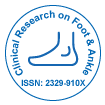Foot Pressure Analysis: Advancements, Applications, and Future Directions
*Corresponding Author: Dr. Meera Rajan, Department of Physical Therapy, Sunrise Orthopedic Institute, India, Email: meera_r@gmail.comReceived Date: Mar 03, 2025 / Accepted Date: Mar 30, 2025 / Published Date: Mar 30, 2025
Citation: Meera R (2025) Foot Pressure Analysis: Advancements, Applications,and Future Directions. Clin Res Foot Ankle, 13: 638.
Copyright: © 2025 Meera R. This is an open-access article distributed under theterms of the Creative Commons Attribution License, which permits unrestricteduse, distribution, and reproduction in any medium, provided the original author andsource are credited.
Abstract
Foot pressure analysis is an essential biomechanical evaluation technique that provides detailed insights into the loading characteristics of the foot during static and dynamic activities. With applications spanning clinical diagnosis, sports science, rehabilitation, and footwear design, this technology has transformed how professionals understand and address foot function and dysfunction. This article provides an in-depth review of foot pressure analysis, including methodologies, clinical significance, recent technological advances, and future research prospects. Foot pressure analysis has emerged as a pivotal biomechanical assessment tool across a wide array of disciplines including clinical diagnostics, sports science, rehabilitation, orthopedics, and wearable technology. By capturing dynamic plantar pressure distributions during various activities such as walking, running, or standing, this technology offers critical insights into foot function, gait patterns, and overall lower limb biomechanics. With the advent of high-resolution sensor arrays, wireless in-shoe systems, and AI-powered data analytics, the capabilities of foot pressure analysis have expanded significantly over the past decade. This review synthesizes recent technological advancements and current methodologies in foot pressure measurement systems, including platform-based, in-shoe, and wearable sensor technologies. It explores the diverse applications of plantar pressure analysis, from diagnosing diabetic foot ulcers and identifying abnormal gait patterns to optimizing athletic performance and guiding surgical or prosthetic interventions. Additionally, the integration of machine learning models for pattern recognition and predictive analytics has opened new avenues in preventive healthcare and personalized treatment planning. Despite substantial progress, challenges remain in terms of standardization, real-world usability, data interpretation, and integration with broader clinical decision-making systems. This article concludes by outlining emerging trends and future directions in foot pressure analysis, emphasizing the need for interdisciplinary collaboration, development of user-friendly interfaces, and ethically grounded deployment in both clinical and non-clinical settings. Ultimately, foot pressure analysis is positioned to become a cornerstone of precision health and human movement sciences.

 Spanish
Spanish  Chinese
Chinese  Russian
Russian  German
German  French
French  Japanese
Japanese  Portuguese
Portuguese  Hindi
Hindi 
